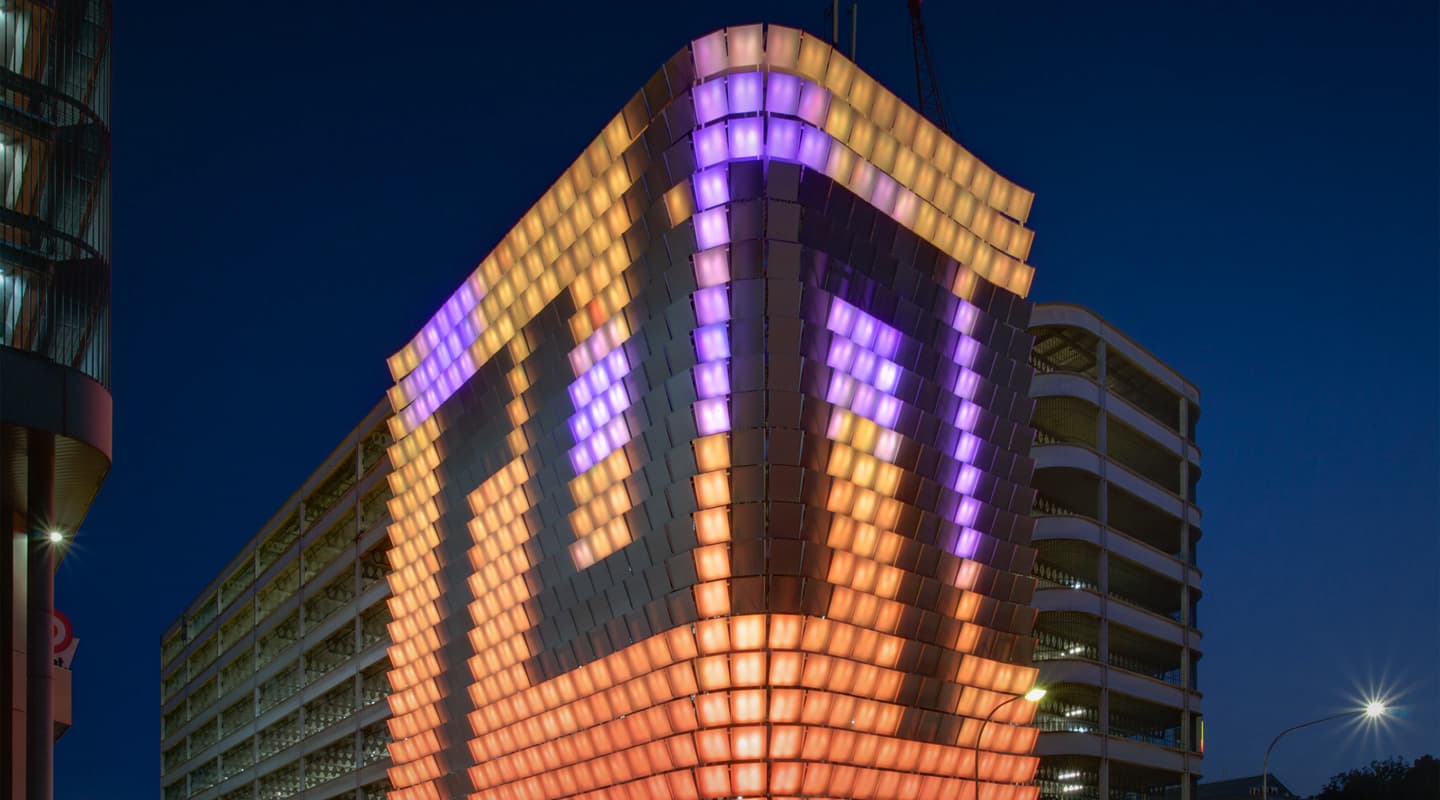
Rundle Lantern
A very different big screen for Adelaide.
Text:/ Andy Ciddor
Let’s be honest, even if you are lucky enough to live there, Adelaide isn’t the first city that springs to mind when you think of innovative town planning and leading-edge public display systems. Perhaps because of this, the Adelaide City Council was looking for something bold and unusual when it ran a design competition for projects to enliven the nightscape at the eastern end of the Rundle Mall. Much to everyone’s surprise the winning concept came from local design consultancy Fusion, the only non-architectural entrant in the competition.
The Rundle Lantern concept proposed by Fusion’s principal, Damien Mair, involved wrapping a low resolution video screen around a rather unattractive eight-storey council car park on the corner opposite the Rundle Mall. The intention was emphatically not to display anything as mundane as football, motor racing, advertising, news or music videos. According to Mair: “The vision for the Lantern was to create an experience that would capture the imagination of the city and add beauty to people’s lives.” Fusion’s proposal included the design, provision and programming of material for the screen that would include seasonal and event-related theming and incorporate creative input from the arts community.
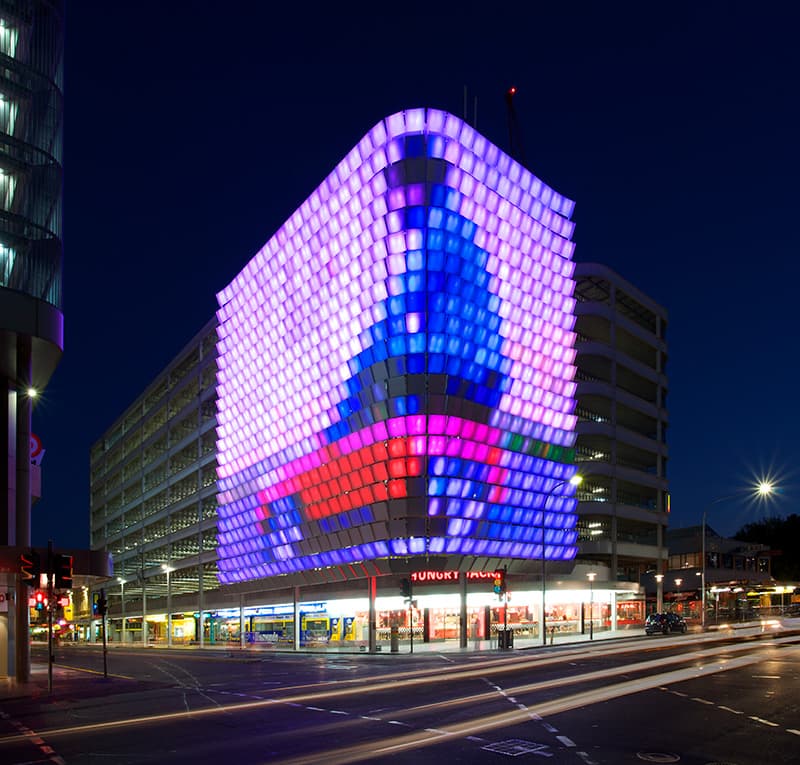
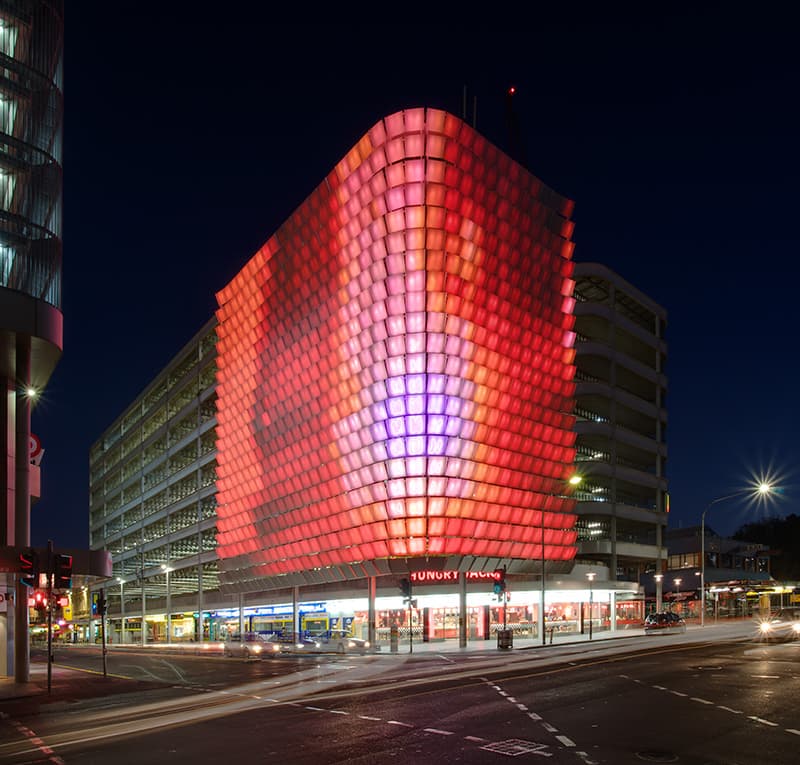
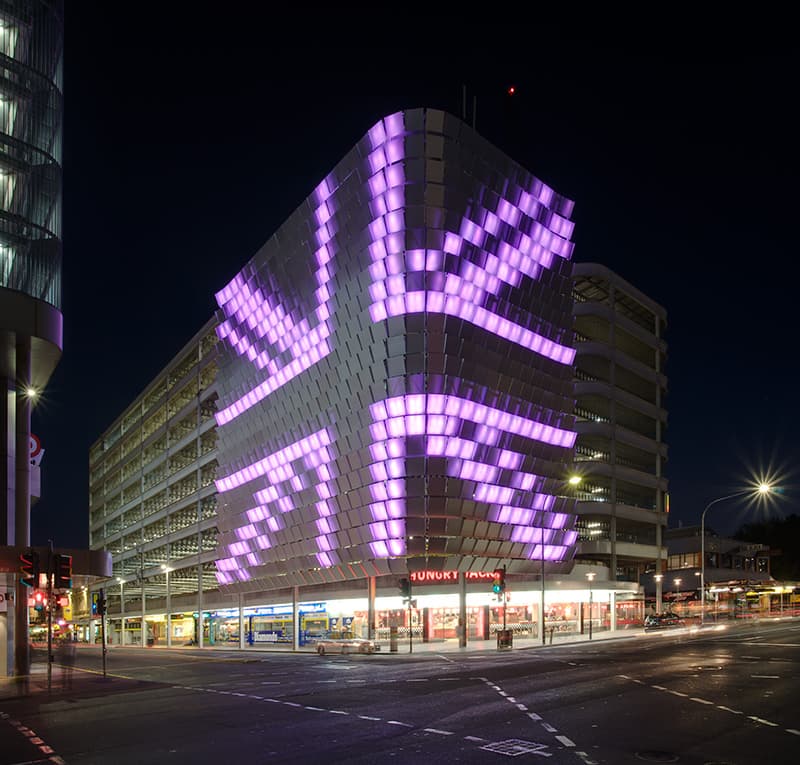
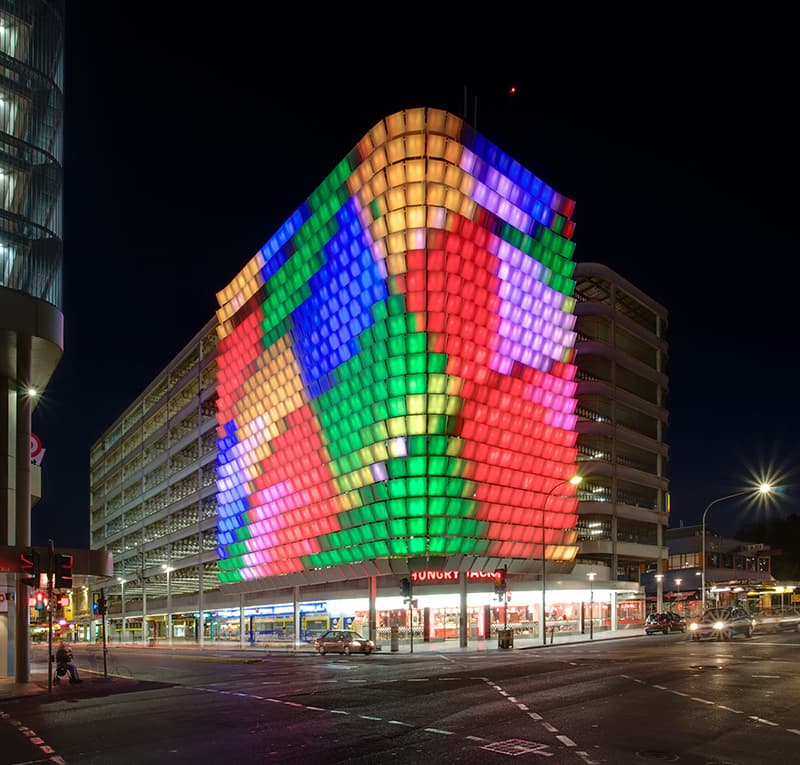
A sample of the moods and flexibility of the Rundle Lantern. Images and sequences are composed remotely at the Fusion studio and uploaded to the Green Hippo controller via a secured broadband link (images courtesy of Fusion).
U PARK U TURN
Wrapping any building with over a 1000sqm of screen presents an interesting engineering and construction challenge, but with this building Fusion had stumbled into some unusual problems. Intended as a minimum-cost ‘temporary solution’ to CBD parking needs in the 1960s, the U Park building was bolted together from oversized meccano set steel beams to straddle the existing single-story shops that fronted on to Rundle street.
The vehicle exhaust ventilation system for the car park followed the common approach of natural ventilation by omitting most of the walls. Discussions with a range of interested parties and engineering consultants, resulted in the specification that any screen installed had to retain 50% of the natural airflow to avoid the budget-crippling need for mechanical ventilation. Clearly a screen that is 50% holes does not make particularly impressive viewing unless you can’t see the holes. The solution was based on the concept of the louvre windows that were so popular in Australian homes before we started using air conditioners.
The final design consisted of 748 anodised aluminium panels, arranged in 22 rows and 34 columns. Each 1.4sqm panel is carefully angled to provide visual continuity from street level, yet retain 50% of the airflow from the original open-wall design. The images are created on the screen by illuminating each panel from light sources hidden in the top of the panel below it.
Realising that LEDs were probably the only type of light source that could provide the colour range, longevity and energy efficiency required for the screen, Fusion went looking around the world for a company that could not only provide the necessary high-output LEDs, but also the control technology to drive them as part of a large screen system.
“”
Wrapping any building with over a 1000sqm of screen presents an interesting engineering and construction challenge
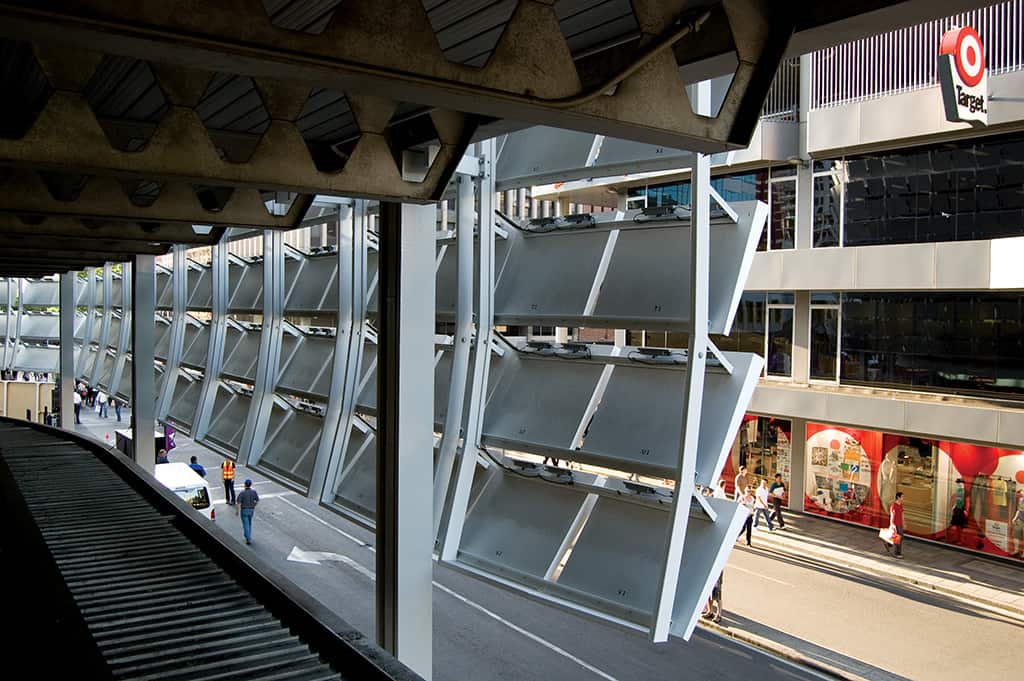
Tiles mounted on the U Park building at angles to allow adequate ventilation of vehicle exhaust fumes.
Images: Andy Ciddor.
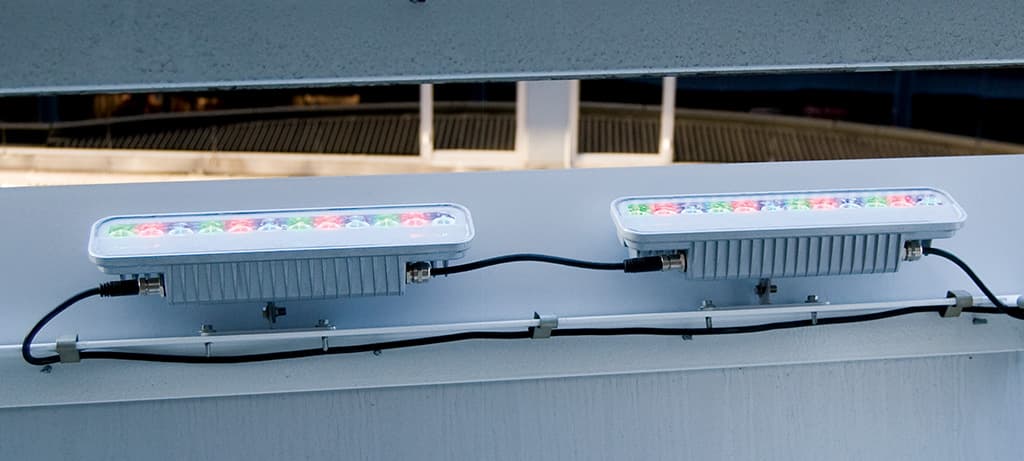
Space Cannon Bisquit fixtures with diffusion on near side for even illumination of the tiles.
SPACE CANNON BROADSIDE
Mair was impressed by the work of Space Cannon of Italy, particularly what had been achieved with the headquarters of the Dexia Group in Brussels, Belgium, which at the time was one of the most sophisticated projects ever attempted. On contacting Space Cannon to enquire about engaging their expertise on the project, Mair was more than a little surprised to find that the control system and programming for the Dexia Group headquarters had actually been done by Melbourne-based Fabian Barzaghi and Dan Ditmann of Space Cannon Australia.
The Space Cannon proposal (that was ultimately implemented on the project), was to light each of the 714 active panels with a pair of independently controlled, custom-built Bisquit LED luminaries, resulting in a display with 1428 addressable ‘pixels’. The Rundle Lantern version of the Bisquit are IP66-rated exterior fixtures, containing 12 high-efficiency LED sources (4 x red, 4 x green and 4 x blue), configured for full-spectrum RGB colour mixing via the DMX512A control protocol, and remotely addressable via the Remote Device Management (RDM) protocol. The Space Cannon package also included the design, commissioning and programming of a suitable data distribution, control and programming system.
Although the Rundle Lantern is low resolution compared to even a standard definition TV, it still requires a rather substantial 4284 channels of lighting DMX512 control to operate it. Feeding DMX data and allocating DMX addresses to 1428 fixtures is not a trivial problem. The DMX network limit of 32 devices connected in any one daisychain necessitated an eight-way optically-isolated splitter for each of the nine DMX universes. Transport for the nine DMX streams was via Ethernet using ArtNet, the public domain DMX-over-Ethernet protocol developed by Artistc Licence in the UK.
Rather than attempt the nightmare task of allocating a DMX address via DIP switches on each fixture at the point where they were either unpacked or fixed to the display panels, Barzaghi and Ditmann had specified that the luminaires should be capable of communicating via the recently ratified Remote Device Management extension to the DMX512 protocol. The RDM software deployed in the Bisquit luminaires was developed for Space Cannon by Australian RDM pioneers Enttec. Using a standard notebook computer fitted with an Enttec RDM interface and controller software, Barzaghi and Ditmann were able to identify and interrogate each fixture once it was in place and assign its allocated address without touching the luminaire, a process that saved many dozens of hours of fiddling, double handling and construction time.
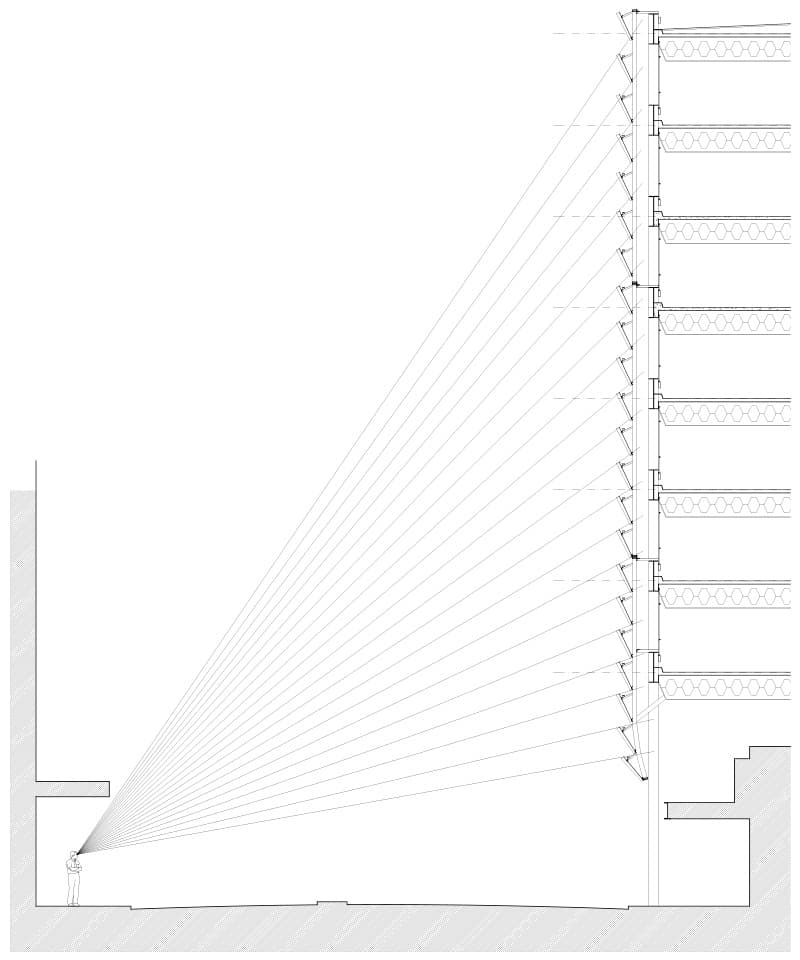
Sightlines were calculated for each tile to provide sufficient visual overlap and optimum ventilation.
(Images courtesy of Fusion)
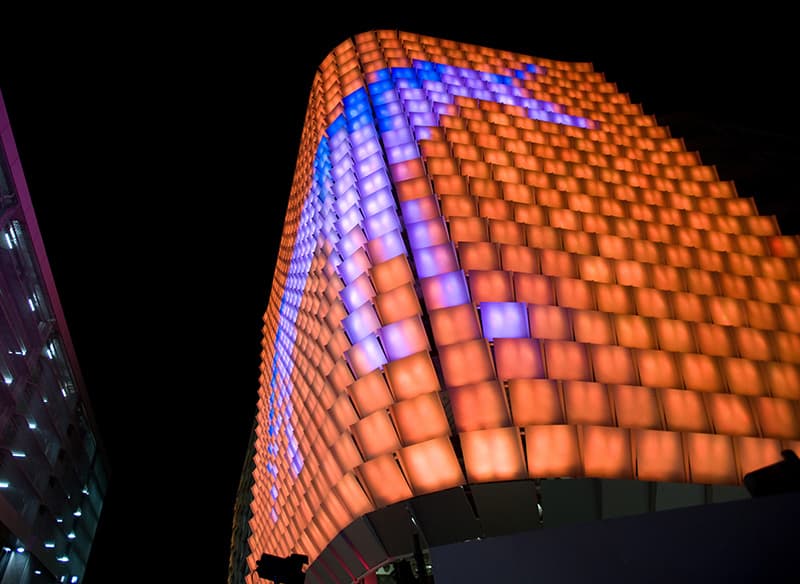
SEEING THE LIGHT
Images for the Lantern are displayed using a Green Hippo Hippotizer V3 Stage media server that takes a video feed and translates it on-the-fly into the appropriate ArtNet control signals to drive the LEDs in each Space Cannon ‘pixel’. The Hippotizer is located (together with its outside communications links) in the bottom of the U Park building. Keeping the Hippotizer company in that rack is an Enttec E-Streamer replay system which, because it has both an astronomical clock and ArtNet output, has been allocated the menial task of powering the LED fixtures up and down for each night’s presentation.
Several floors above the Hippotizer, perched in a corner of the carpark near the midpoint of the screen, is the control rack packed with Enttec DataGate, EtherGate, and ODE ArtNet-to-DMX converters, a pile of Tech Art DMX splitters, power distribution modules, a relay rack and a large collection TechArt DMX patch panels.
Content creation and management for the Lantern is supplied as part of an ongoing contract by the design team at Fusion, using Green Hippo’s Pixel Mapper software and the Zoo Keeper remote management software, from their facility in central Adelaide.
Although starting out as a project that would probably call on a range of outside consultants and overseas companies, the majority of this landmark development was put together by a team of world-class locals.
See some of the Rundle Lantern programming live on webcam (it updates every five seconds) at www.cityofadelaide.com.au/rundlelantern
Andy Ciddor attended the opening of the Rundle Lantern as a guest of Space Cannon Australia.
EQUIPMENT LIST
1428 x Space Cannon Bisquit custom 12 LED RDM
9 x TecArt Splitter 8 way opto isolated
9 x TecArt 8 way patch panels
1 x TecArt 12 channel relay rack
1 x Enttec E-Streamer
1 x Enttec Datagate DE
1 x Enttec Ethergate
1 x Enttec ODE
1 x Green Hippo Hippotizer V3 Stage with Pixelmapper software and Zoo Keeper
1 x Netgear Gigabit switch

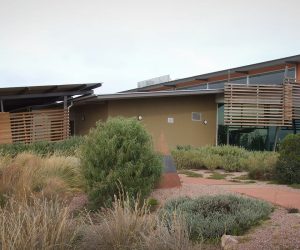

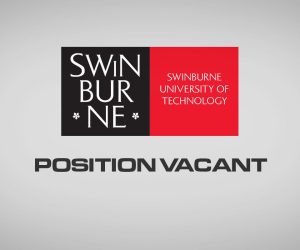

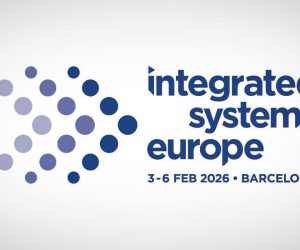

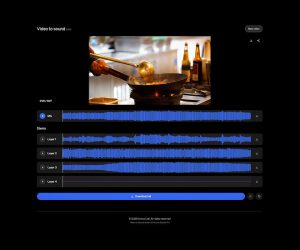
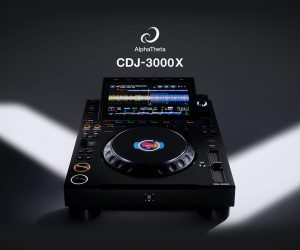






RESPONSES